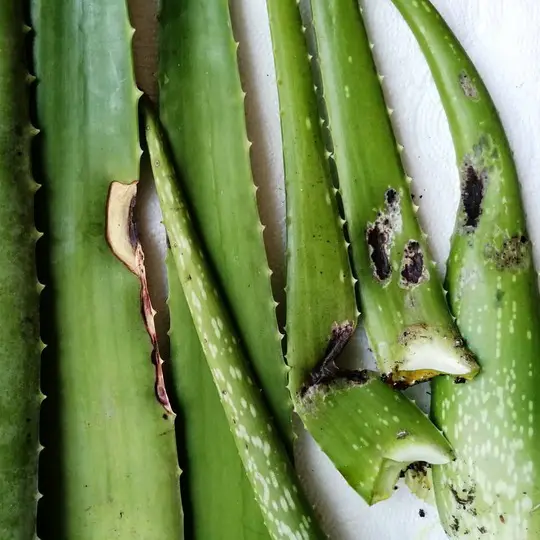Root rot is a common and serious problem for Aloe Vera plants, often caused by overwatering or poorly draining soil. Knowing how to diagnose and treat root rot in Aloe Vera early can save your plant from irreversible damage. Recognizing the symptoms quickly allows for timely intervention and better chances of recovery.
Aloe Vera thrives in dry, well-drained conditions, making it vulnerable when roots stay wet too long. This guide will help you identify the signs of root rot, understand its causes, and apply effective treatments to restore your Aloe Vera’s health and vitality.

Understanding Root Rot in Aloe Vera
Root rot in Aloe Vera is primarily a fungal disease caused by pathogens such as Phytophthora, Pythium, or Fusarium species. These fungi thrive in overly moist, poorly aerated soil environments, attacking the plant’s roots and preventing nutrient absorption. Once infected, the roots become soft, brown, and mushy, compromising the plant’s overall health.
Aloe Vera is a succulent adapted to arid conditions, so excessive watering or heavy, compacted soil creates the perfect environment for root rot to develop. Symptoms include yellowing leaves, wilting, and a foul smell near the root zone, signaling advanced decay. Early detection is critical to preventing permanent damage or plant death.
Key factors contributing to root rot in Aloe Vera include:
- Overwatering and poor drainage
- Use of non-porous containers
- Heavy or water-retentive soil mixes
Understanding these causes helps gardeners adjust care practices and create an environment that supports healthy Aloe Vera growth.
How to Identify Root Rot Symptoms
Identifying root rot symptoms early is essential to saving your Aloe Vera plant. The most common signs include yellowing or browning of the leaves, which often start at the base and gradually spread upward. The leaves may also become soft, limp, or mushy, losing their usual firmness and vibrant green color. If you notice your Aloe Vera wilting despite regular watering, root rot could be the underlying issue.
Another clear symptom is the presence of a foul, musty odor coming from the soil or root area. This smell indicates decaying roots caused by fungal infection. When you gently remove the plant from its pot, check the roots — healthy roots are white or light tan and firm, whereas rotted roots are dark brown or black, soft, and slimy.
Additional indicators include:
- Slow or stunted growth
- Leaf drop or unusual leaf curling
Promptly recognizing these symptoms allows you to intervene before the damage spreads, increasing your chances of recovery.
Preventing Root Rot in Aloe Vera
Prevention is the best strategy to protect your Aloe Vera from root rot. Since this condition thrives in overly wet and poorly drained environments, ensuring proper watering habits is crucial. Water your Aloe Vera sparingly—only when the soil is completely dry to the touch. Overwatering is the most common cause of root rot, so letting the soil dry out between watering sessions mimics the plant’s natural arid habitat.
Using well-draining soil specifically designed for succulents and cacti is another important preventive measure. These mixes typically contain sand, perlite, or pumice, which improve aeration and prevent water from pooling around the roots. Additionally, selecting pots with adequate drainage holes allows excess water to escape, reducing the risk of root saturation.
Key prevention tips include:
- Water only when the top 2 inches of soil are dry
- Use a succulent or cactus potting mix
- Ensure containers have drainage holes
- Avoid placing Aloe Vera in humid, low-ventilation areas
By adopting these practices, you create an environment that discourages fungal growth and keeps your Aloe Vera healthy and thriving.
Diagnosing the Problem
Diagnosing root rot in Aloe Vera requires a combination of visual inspection and careful evaluation of growing conditions. Start by examining the plant for external symptoms such as yellowing, wilting, or mushy leaves. These signs often indicate underlying root issues. Next, gently remove the Aloe Vera from its pot to inspect the roots directly. Healthy roots are firm, white or light tan, while roots affected by rot appear dark, soft, and slimy.
Check the soil moisture level and drainage. Overly wet, compacted, or soggy soil is a strong indicator of root rot. Additionally, assess recent watering habits—frequent watering or poor drainage can contribute to fungal infections. Look for any foul odors from the root zone, which often accompany rot.
Consider these diagnostic steps:
- Visual inspection of leaves and stem for distress signals
- Root examination for discoloration and texture
- Soil moisture and drainage assessment
Accurate diagnosis is crucial for deciding whether treatment or plant replacement is necessary, so take your time to thoroughly evaluate all signs.
How to Treat Root Rot in Aloe Vera
Treating root rot in Aloe Vera involves prompt action to remove infected roots and improve growing conditions. Start by carefully uprooting the plant and gently shaking off the wet soil to expose the root system. Using sterilized scissors or pruning shears, trim away all dark, mushy, or rotten roots, cutting back to healthy, firm tissue. Dispose of the infected material properly to prevent spreading fungal spores.
After pruning, allow the Aloe Vera roots to dry and callous over for 24 to 48 hours in a warm, shaded area. This drying phase helps prevent further fungal infection. Once dry, repot the plant in fresh, well-draining succulent soil and a pot with proper drainage holes. Avoid watering for at least a week to let the roots settle and recover.
Additional treatment tips:
- Use a fungicide designed for root rot if infection is severe
- Adjust watering habits to prevent recurrence
- Ensure good airflow around the plant
With timely treatment and improved care, your Aloe Vera can often recover fully from root rot and regain vitality.
Aftercare and Recovery
After treating root rot, proper aftercare is essential to help your Aloe Vera recover and thrive. Initially, avoid watering the plant for about one to two weeks, allowing the roots to heal and establish themselves in fresh soil. When you resume watering, do so sparingly, ensuring the soil dries out completely between sessions to prevent moisture buildup.
Place your Aloe Vera in a bright, indirect light location to encourage healthy growth without stressing the recovering plant. Good airflow is also important, as stagnant air can promote fungal growth. Monitor the plant closely for new growth, which is a positive sign of recovery.
Key aftercare steps include:
- Gradual reintroduction of watering after 1-2 weeks
- Providing bright, indirect sunlight
- Maintaining well-draining soil and adequate airflow
- Regularly inspecting roots and leaves for any recurrence of symptoms
With consistent care, your Aloe Vera can bounce back from root rot, becoming strong and vibrant once again.
When to Seek Expert Help
Persistent Symptoms Despite Treatment
If your Aloe Vera continues to show signs of distress—such as yellowing leaves, wilting, or foul smells—even after you’ve treated root rot and adjusted care, it’s time to consult a professional. Persistent symptoms may indicate a deeper infection or other underlying issues like pest infestations or nutrient deficiencies that require expert diagnosis.
Extensive Root Damage
When root rot has severely damaged the root system, your attempts to save the plant might not be enough. If most roots are blackened and mushy, and the plant’s structure is weak or collapsing, a gardening expert or plant pathologist can offer guidance on whether the plant can be salvaged or if replacement is necessary.
Need for Advanced Treatment Options
Sometimes, home remedies and basic fungicides aren’t sufficient to combat stubborn fungal infections. Experts have access to specialized treatments and can recommend or apply systemic fungicides that are more effective. They can also advise on soil sterilization techniques and environmental changes to prevent future outbreaks.
Seeking expert advice ensures your Aloe Vera gets the best chance at recovery and helps you avoid repeated mistakes, promoting long-term plant health and success.
Learning from Root Rot Experience
Experiencing root rot with your Aloe Vera can be frustrating, but it offers valuable lessons for improving your plant care practices. One key takeaway is the importance of understanding your plant’s specific needs, especially regarding watering frequency and soil type. Aloe Vera thrives in dry, well-draining conditions, so adjusting your care routine to mimic its natural habitat can prevent future issues.
This experience also highlights the value of regular monitoring. Early detection of symptoms like leaf discoloration or unusual softness can save your plant from severe damage. Taking immediate action when signs appear helps maintain healthy growth and prevents root rot from progressing.
Additionally, learning to properly diagnose and treat root rot equips you with the confidence to handle similar plant health challenges in the future. By applying these lessons, you’ll develop stronger gardening skills and create a thriving environment for all your succulents.
Creating a Plant-Friendly Environment
Creating an optimal environment for your Aloe Vera is crucial in preventing root rot and ensuring overall plant health. Aloe Vera thrives in bright, indirect sunlight, so placing it near a south- or west-facing window where it receives ample but filtered light is ideal. Avoid exposing the plant to harsh, direct sunlight for prolonged periods, as this can cause leaf burn and stress.
Maintaining proper air circulation around your Aloe Vera helps reduce humidity levels and prevents fungal growth. Avoid overcrowding plants and ensure your growing space has good ventilation. Temperature control is also important; Aloe Vera prefers temperatures between 55°F and 80°F (13°C to 27°C) and can suffer if exposed to cold drafts or extreme heat.
To summarize, focus on:
- Providing bright, indirect sunlight
- Ensuring good air circulation
- Maintaining stable, moderate temperatures
- Using well-draining soil and pots with drainage holes
By cultivating these conditions, you create a healthy, balanced environment that supports Aloe Vera’s natural growth and resilience.
Final Thoughts
Root rot is a common but manageable challenge when growing Aloe Vera. Understanding how to diagnose and treat root rot in Aloe Vera empowers gardeners to act swiftly and protect their plants. Prevention through proper watering, soil choice, and environment control remains the best defense against this condition.
With patience and attentive care, Aloe Vera can recover from root rot and continue to thrive as a resilient, low-maintenance succulent. Embracing the lessons learned from any setbacks will improve your overall gardening skills and help you cultivate healthier plants in the long run.

I’m Shofi, a passionate gardener and blogger. I have 10+ years of experience in gardening and hold certifications in horticulture and garden design. I share my knowledge and skills through my garden blog to inspire and educate others on the joys of gardening. I try to provide valuable information and create a community for gardeners of all levels to connect and learn. My ultimate goal is to inspire others to start their own gardens and connect with nature.
